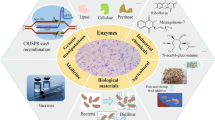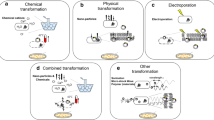Abstract
L-tryptophan (L-trp) production in Escherichia coli has been developed by employing random mutagenesis and selection for a long time, but this approach produces an unclear genetic background. Here, we generated the L-trp overproducer TPD5 by combining an intracellular L-trp biosensor and fluorescence-activated cell sorting (FACS) in E. coli, and succeeded in elucidating the genetic basis for L-trp overproduction. The most significant identified positive mutations affected TnaA (deletion), AroG (S211F), TrpE (A63V), and RpoS (nonsense mutation Q33*). The underlying structure–function relationships of the feedback-resistant AroG (S211F) and TrpE (A63V) mutants were uncovered based on protein structure modeling and molecular dynamics simulations, respectively. According to transcriptomic analysis, the global regulator RpoS not only has a great influence on cell growth and morphology, but also on carbon utilization and the direction of carbon flow. Finally, by balancing the concentrations of the L-trp precursors’ serine and glutamine based on the above analysis, we further increased the titer of L-trp to 3.18 g/L with a yield of 0.18 g/g. The analysis of the genetic characteristics of an L-trp overproducing E. coli provides valuable information on L-trp synthesis and elucidates the phenotype and complex cellular properties in a high-yielding strain, which opens the possibility to transfer beneficial mutations and reconstruct an overproducer with a clean genetic background.








Similar content being viewed by others
References
Yu AQ, Pratomo Juwono NK, Foo JL, Leong SSJ, Chang MW (2016) Metabolic engineering of Saccharomyces cerevisiae for the overproduction of short branched-chain fatty acids. Metab Eng 34:36–43. https://doi.org/10.1016/j.ymben.2015.12.005
Rogers JK, Church GM (2016) Genetically encoded sensors enable real-time observation of metabolite production. Proc Natl Acad Sci USA 113:2388–2393. https://doi.org/10.1073/pnas.1600375113
Pontrelli S, Fricke RCB, Teoh ST, Lavina WA, Putri SP, Fitz-Gibbon S, Chung M, Pellegrini M, Fukusaki E, Liao JC (2018) Metabolic repair through emergence of new pathways in Escherichia coli. Nat Chem Biol 14:1005–1009. https://doi.org/10.1038/s41589-018-0149-6
Barata D, van Blitterswijk C, Habibovic P (2016) High-throughput screening approaches and combinatorial development of biomaterials using microfluidics. Acta Biomater 34:1–20. https://doi.org/10.1016/j.actbio.2015.09.009
Xiao Y, Bowen CH, Liu D, Zhang F (2016) Exploiting nongenetic cell-to-cell variation for enhanced biosynthesis. Nat Chem Biol 12:339–344. https://doi.org/10.1038/nchembio.2046
Dragosits M, Mattanovich D (2013) Adaptive laboratory evolution—principles and applications for biotechnology. Microb Cell Fact 12:64. https://doi.org/10.1186/1475-2859-12-64
Wang G, Shi T, Chen T, Wang X, Wang Y, Liu D, Guo J, Fu J, Feng L, Wang Z, Zhao X (2018) Integrated whole-genome and transcriptome sequence analysis reveals the genetic characteristics of a riboflavin-overproducing Bacillus subtilis. Metab Eng 48:138–149. https://doi.org/10.1016/j.ymben.2018.05.022
Liu L, Li Y, Li S, Hu N, He Y, Pong R, Lin D, Lu L, Law M (2012) Comparison of next-generation sequencing systems. J Biomed Biotechnol 2012:251364. https://doi.org/10.1155/2012/251364
Ansorge WJ (2009) Next-generation DNA sequencing techniques. N Biotechnol 25:195–203. https://doi.org/10.1016/j.nbt.2008.12.009
McKie SJ, Maxwell A, Neuman KC (2020) Mapping DNA topoisomerase binding and cleavage genome wide using next-generation sequencing techniques. Genes (Basel). https://doi.org/10.3390/genes11010092
Hancock-Hanser BL, Frey A, Leslie MS, Dutton PH, Archer FI, Morin PA (2013) Targeted multiplex next-generation sequencing: advances in techniques of mitochondrial and nuclear DNA sequencing for population genomics. Mol Ecol Resour 13:254–268. https://doi.org/10.1111/1755-0998.12059
Schena M, Shalon D, Davis RW, Brown PO (1995) Quantitative monitoring of gene expression patterns with a complementary DNA microarray. Science 270:467–470. https://doi.org/10.1126/science.270.5235.467
Chen L, Zeng AP (2017) Rational design and metabolic analysis of Escherichia coli for effective production of L-tryptophan at high concentration. Appl Microbiol Biotechnol 101:559–568. https://doi.org/10.1007/s00253-016-7772-5
Porter RJ, Mulder RT, Joyce PR, Luty SE (2005) Tryptophan and tyrosine availability and response to antidepressant treatment in major depression. J Affect Disord 86:129–134. https://doi.org/10.1016/j.jad.2004.11.006
Du L, Zhang Z, Xu Q, Chen N (2019) Central metabolic pathway modification to improve L-tryptophan production in Escherichia coli. Bioengineered 10:59–70. https://doi.org/10.1080/21655979.2019.1592417
Liu Q, Cheng Y, Xie X, Xu Q, Chen N (2012) Modification of tryptophan transport system and its impact on production of L-tryptophan in Escherichia coli. Bioresour Technol 114:549–554. https://doi.org/10.1016/j.biortech.2012.02.088
Wang J, Cheng LK, Wang J, Liu Q, Shen T, Chen N (2013) Genetic engineering of Escherichia coli to enhance production of L-tryptophan. Appl Microbiol Biotechnol 97:7587–7596. https://doi.org/10.1007/s00253-013-5026-3
Cheng LK, Wang J, Xu QY, Zhao CG, Shen ZQ, Xie XX, Chen N (2013) Strategy for pH control and pH feedback-controlled substrate feeding for high-level production of L-tryptophan by Escherichia coli. World J Microbiol Biotechnol 29:883–890. https://doi.org/10.1007/s11274-012-1243-7
Dodge TC, Gerstner JM (2002) Optimization of the glucose feed rate profile for the production of tryptophan from recombinant E coli. J Chem Technol Biotechnol 77:1238–1245. https://doi.org/10.1002/jctb.698
Fang M, Wang T, Zhang C, Bai J, Zheng X, Zhao X, Lou C, Xing XH (2016) Intermediate-sensor assisted push-pull strategy and its application in heterologous deoxyviolacein production in Escherichia coli. Metab Eng 33:41–51. https://doi.org/10.1016/j.ymben.2015.10.006
Chen Y, Liu Y, Ding D, Cong L, Zhang D (2018) Rational design and analysis of an Escherichia coli strain for high-efficiency tryptophan production. J Ind Microbiol Biotechnol 45:357–367. https://doi.org/10.1007/s10295-018-2020-x
Burley SK, Berman HM, Bhikadiya C, Bi C, Chen L, Di Costanzo L, Christie C, Dalenberg K, Duarte JM, Dutta S, Feng Z, Ghosh S, Goodsell DS, Green RK, Guranovic V, Guzenko D, Hudson BP, Kalro T, Liang Y, Lowe R, Namkoong H, Peisach E, Periskova I, Prlic A, Randle C, Rose A, Rose P, Sala R, Sekharan M, Shao C, Tan L, Tao YP, Valasatava Y, Voigt M, Westbrook J, Woo J, Yang H, Young J, Zhuravleva M, Zardecki C (2019) RCSB Protein Data Bank: biological macromolecular structures enabling research and education in fundamental biology, biomedicine, biotechnology and energy. Nucleic Acids Res 47:D464–D474. https://doi.org/10.1093/nar/gky1004
Roy A, Kucukural A, Zhang Y (2010) I-TASSER: a unified platform for automated protein structure and function prediction. Nat Protoc 5:725–738. https://doi.org/10.1038/nprot.2010.5
Schrödinger Release 2018-1 (2018) Glide S, LLC, New York
Case DA, Ben-Shalom IY, Brozell SR, Cerutti DS, Cheatham III TE, Cruzeiro VWD, Darden TA, Duke RE, Ghoreishi D, Gilson MK, Gohlke H, Goetz AW, Greene D, Harris R, Homeyer N, Huang Y, Izadi S, Kovalenko A, Kurtzman T, Lee TS, LeGrand S, Li P, Lin C, Liu J, Luchko T, Luo R, Mermelstein DJ, Merz KM, Miao Y, Monard G, Nguyen C, Nguyen H, Omelyan I, Onufriev A, Pan F, Qi R, Roe DR, Roitberg A, Sagui C, Schott-Verdugo S, Shen J, Simmerling CL, Smith J, Salomon-Ferrer R, Swails J, Walker RC, Wang J, Wei H, Wolf RM, Wu X, Xiao L, York DM, Kollman PA (2018) AMBER 2018. University of California, San Francisco
Hopkins CW, Le Grand S, Walker RC, Roitberg AE (2015) Long-time-step molecular dynamics through hydrogen mass repartitioning. J Chem Theory Comput 11:1864–1874. https://doi.org/10.1021/ct5010406
Rodriguez A, Martinez JA, Flores N, Escalante A, Gosset G, Bolivar F (2014) Engineering Escherichia coli to overproduce aromatic amino acids and derived compounds. Microb Cell Fact 13:126. https://doi.org/10.1186/s12934-014-0126-z
Smith LC, Ravel JM, Lax SR, Shive W (1962) The control of 3-deoxy-D-arabino-heptulosonic acid 7-phosphate synthesis by phenylalanine and tyrosine. J Biol Chem 237:3566–3570
Li H, Liang C, Chen W, Jin JM, Tang SY, Tao Y (2017) Monitoring in vivo metabolic flux with a designed whole-cell metabolite biosensor of shikimic acid. Biosens Bioelectron 98:457–465. https://doi.org/10.1016/j.bios.2017.07.022
Ger YM, Chen SL, Chiang HJ, Shiuan D (1994) A single Ser-180 mutation desensitizes feedback inhibition of the phenylalanine-sensitive 3-deoxy-D-arabino-heptulosonate 7-phosphate (DAHP) synthetase in Escherichia coli. J Biochem 116:986–990. https://doi.org/10.1093/oxfordjournals.jbchem.a124657
Zhao ZJ, Zou C, Zhu YX, Dai J, Chen S, Wu D, Wu J, Chen J (2011) Development of L-tryptophan production strains by defined genetic modification in Escherichia coli. J Ind Microbiol Biotechnol 38:1921–1929. https://doi.org/10.1007/s10295-011-0978-8
Fang MY, Zhang C, Yang S, Cui JY, Jiang PX, Lou K, Wachi M, Xing XH (2015) High crude violacein production from glucose by Escherichia coli engineered with interactive control of tryptophan pathway and violacein biosynthetic pathway. Microb Cell Fact 14:8. https://doi.org/10.1186/s12934-015-0192-x
Zhang Y (2008) I-TASSER server for protein 3D structure prediction. BMC Bioinformatics 9:40. https://doi.org/10.1186/1471-2105-9-40
Landini P, Egli T, Wolf J, Lacour S (2014) sigmaS, a major player in the response to environmental stresses in Escherichia coli: role, regulation and mechanisms of promoter recognition. Environ Microbiol Rep 6:1–13. https://doi.org/10.1111/1758-2229.12112
Patten CL, Kirchhof MG, Schertzberg MR, Morton RA, Schellhorn HE (2004) Microarray analysis of RpoS-mediated gene expression in Escherichia coli K-12. Mol Genet Genomics 272:580–591. https://doi.org/10.1007/s00438-004-1089-2
Qian ZG, Xia XX, Lee SY (2009) Metabolic engineering of Escherichia coli for the production of putrescine: a four carbon diamine. Biotechnol Bioeng 104:651–662. https://doi.org/10.1002/bit.22502
Zhang Y, Shi C, Yu J, Ren J, Sun D (2012) RpoS regulates a novel type of plasmid DNA transfer in Escherichia coli. PLoS ONE 7:e33514. https://doi.org/10.1371/journal.pone.0033514
Liu Q, Zhang J, Wei XX, Ouyang SP, Wu Q, Chen GQ (2008) Microbial production of L-glutamate and L-glutamine by recombinant Corynebacterium glutamicum harboring Vitreoscilla hemoglobin gene vgb. Appl Microbiol Biotechnol 77:1297–1304. https://doi.org/10.1007/s00253-007-1254-8
Acknowledgements
This work was supported by the National Key R&D Program of China (2020YFA0907800), Tianjin Synthetic Biotechnology Innovation Capacity Improvement Project (TSBICIP-KJGG-004-03), the National Natural Science Foundation of China (NSFC 31800086), National Key R&D Plan Special Project for “Synthetic biology” (2018YFA0901402, 2019YFA0904901).
Author information
Authors and Affiliations
Corresponding author
Ethics declarations
Conflict of interest
The authors declare that they have no competing interests.
Additional information
Publisher's Note
Springer Nature remains neutral with regard to jurisdictional claims in published maps and institutional affiliations.
Supplementary Information
Below is the link to the electronic supplementary material.
Rights and permissions
About this article
Cite this article
Ding, D., Bai, D., Li, J. et al. Analyzing the genetic characteristics of a tryptophan-overproducing Escherichia coli. Bioprocess Biosyst Eng 44, 1685–1697 (2021). https://doi.org/10.1007/s00449-021-02552-4
Received:
Accepted:
Published:
Issue Date:
DOI: https://doi.org/10.1007/s00449-021-02552-4




